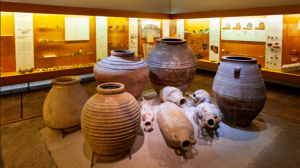Cultural heritage represents the legacy of physical artifacts and intangible attributes of a group or society, passed down from generation to generation. It composes everything from ancient monuments and artifacts to traditional languages and practices, including local culinary traditions. These elements not only tell the story of a community’s past but also shape its present identity and influence its future.
Aside from embodying a community’s shared history and values, cultural heritage has also proven to be a key factor that holds significant potential for economic growth. Communities across the globe stand to unlock a wealth of economic benefits, from job creation to increased tourism revenue by prioritizing the conservation and celebration of our unique traditions. Hence, in this current era of rapid globalization, preserving and promoting cultural heritage has become more crucial than ever for these reasons.
Let’s look into how cultural heritage preservation is not just about honoring the past, but acts also as a powerful tool for sustainable economic development.
1. Cultural Heritage and Tourism Development

Cultural heritage plays a major role in tourism development as it serves as a major attraction for travelers seeking meaningful connections and authentic experiences with diverse cultures. When preserved and promoted effectively, cultural heritage not only attracts tourists but also generates substantial economic benefits for local communities.
One major way cultural heritage benefits the economy is by promoting Heritage Tourism. Heritage tourism refers to a branch of tourism focused on experiencing the culture, history, and traditions of a destination. This form of tourism has become one of the fastest-growing sectors within the global tourism industry as, every year, millions of tourists are drawn to different types of cultural attractions, including historic cities, ancient monuments, traditional music festivals, and local art galleries.
For instance, key UNESCO World Heritage Sites, such as the Pyramids of Giza in Egypt, the Great Wall of China, and Machu Picchu in Peru, are renowned top tourist destinations that attract international visitors. This influx of tourists to heritage sites drives demand for various services, such as guided tours, transportation, hospitality, and food services, which in turn creates opportunities for generating revenue that can be reinvested into the community to improve living standards and enhance local infrastructure.
2. Cultural Heritage and Job Creation

Heritage preservation directly supports the tourism industry, which, in turn, fuels demand for jobs in various fields, including; hospitality, guiding services, event planning, and transportation. Hence, tour guides, translators, and local historians often find employment in heritage tourism, where they get a chance to share their knowledge with visitors and enhance the overall tourist experience. In addition, as tourists visit heritage-rich areas in large numbers, the need for specialized roles like heritage site managers, conservationists, and restoration specialists rises, creating opportunities for skilled workers dedicated to maintaining these sites. These roles help preserve cultural treasures while also creating a local workforce that can support the broader tourism industry.
Heritage tourism often supports the growth of small businesses, especially ones that create traditional handicrafts, souvenirs, and artisan goods. These small businesses benefit economically when visitors purchase their crafts as mementos of their cultural experiences. In addition, heritage tourism can increase demand for traditional foods and beverages, benefiting local farmers, chefs, and food vendors. To further maximize these economic benefits, many regions set up marketplaces, festivals, and cultural fairs where artisans can showcase and sell their creations. These events bring in tourists and locals alike, creating a vibrant cultural economy that preserves artisanal skills and provides income for local communities.
Similarly, heritage tourism also increases the need for continuous restoration and maintenance of heritage sites. This, in turn, creates employment opportunities in construction and skilled trades as heritage preservation projects often require specific expertise in areas such as masonry, carpentry, architecture, and archaeology to help maintain the authenticity and integrity of historical structures. This demand creates jobs for local construction workers, engineers, architects, and specialists. In addition, cultural centers, museums, and heritage sites often employ educators, curators, archivists, and researchers to study and interpret historical materials, share stories of the past, and develop programs for visitors.
3. Cultural Heritage and Infrastructure Development

Investing in heritage sites also helps promote infrastructure development, drive economic growth, and improve the quality of life for local communities. By prioritizing cultural heritage, regions often attract investments that bring modern amenities, improved accessibility, and environmental sustainability, transforming heritage sites into sustainable economic assets. Improving accessibility includes building or upgrading roads, bridges, transportation hubs, and pathways that lead to these sites. This results in improved infrastructure that makes it easier for tourists and locals to reach heritage destinations. This, in turn, increases visitor numbers and stimulates local businesses.
The development of heritage sites also involves investments in essential utilities and public amenities, such as water, electricity, sanitation, and waste management systems. Such upgrades improve the visitor experience and also benefit nearby communities. Also, an increase in visitors to heritage sites increases the need for improved healthcare and emergency response facilities to ensure the safety and well-being of tourists. Surrounding communities benefit as new clinics, health centers, and emergency response units are established to meet this need. The addition of these facilities enhances safety for both tourists and local residents as greater access to healthcare services is provided.
Markets near heritage sites are either upgraded or constructed to accommodate the needs of tourists. This provides dedicated spaces for local artisans, food vendors, and shop owners to showcase their products, allowing communities to tap into the tourism economy directly. These upgrades might include covered stalls, improved lighting, and dedicated spaces for local goods. Such infrastructure not only makes the marketplace more attractive to visitors but also enables local vendors to conduct business in well-organized, safe, and comfortable environments. As a result, surrounding communities are provided with a reliable source of income, ensuring that revenue gained remains within the community.
In conclusion, preserving and promoting cultural heritage promises various economic benefits that extend beyond tourism. Heritage sites play a pivotal role in local economies, creating jobs, attracting investments, and driving infrastructural upgrades that improve quality of life for surrounding communities. By integrating sustainable practices and prioritizing community engagement, heritage preservation can balance economic growth with cultural integrity.
References
Aga Khan Development Network (n.d.) 5 ways restoration of cultural heritage drives economic growth. https://the.akdn/en/resources-media/whats-new/spotlights/5-ways-restoration-of-cultural-heritage-drives-economic-growth
Apofeed, (2023). Harnessing Cultural Heritage as a Catalyst for Economic Growth. African Business. https://african.business/2023/09/apo-newsfeed/harnessing-cultural-heritage-as-a-catalyst-for-economic-growth
Archaeonova, (n.d.).How Cultural Heritage Influences Economic Development. https://archaeonova.com/details-6112000-how-cultural-heritage-influences-economic-development.html



